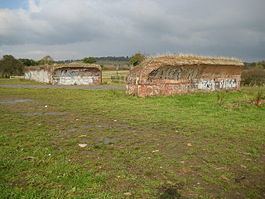Owner Never Opened | Grid reference TQ187931 Number of platforms 2 | |
 | ||
Lists of stations DLRUndergroundNational RailTramlink Similar Elstree South tube station, Stroud Green railway st, City Road tube station, London Underground, King William Street tub | ||
Brockley Hill was a proposed London Underground station in the Brockley Hill area of north London. The planned location was close to Edgwarebury Park and the north side of the junction of the A41 (Watford Bypass) and the A410 roads.
History
The station was the first of three planned by London Underground in 1935 to extend the Northern line from Edgware to Bushey Heath. There was debate about the name for the station, with Edgewarebury, North Edgware and All Souls all being proposed.
The extension was part of the Northern Heights project to electrify steam-operated London and North Eastern Railway (LNER) branch lines and incorporate them into the Northern line. The powers to build the extension came from the purchase in 1922 of the unbuilt Watford and Edgware Railway which had planned an extension of the Edgware, Highgate and London Railway to Watford Junction via Bushey, but had never raised the capital required.
Construction on the Northern Heights project began in the late 1930s but was interrupted by the Second World War. Most of the work to that date had been carried out on LNER branch tracks but some work between Edgware and Bushey Heath had taken place. The route of the line had been laid out and some earthworks constructed. After leaving Edgware Station, the line was to pass under Station Road. The parade of shops on the north side of the road had a narrower building under which the line was to pass, going under Rectory Lane and emerging into a cutting. The photographs are taken from the back of the shops (Rectory Lane side). Now a car park, at carriageway level, stands where the cutting would have been.
Continuing northwards, the route was a strip of land that is now occupied by Campbell Croft on the south side of Purcell's Avenue.
Onwards across the other side of Purcell's Avenue, the track bed is now Shelley Close, the last section of this route to have been given over to housing. The continuation of the track largely follows Sterling Avenue. After this, the line was to have bridged over the A41 main road and thence into Brockley Hill station.
On the site of Brockley Hill station, construction of arches of a viaduct to carry the track over low ground had begun.
The sites of the new stations were semi-rural and, as elsewhere, it was intended that the new section would stimulate the construction of housing estates that the stations would serve. After the war, new legislation limited expansion of urban areas into the countryside. This created the Metropolitan Green Belt around London and the area covered the Northern line extension. Without housing estates, the line had no purpose and the plans were cancelled in 1950. Some consideration was given to finishing the station at Brockley Hill, as it had some housing and the site lay just within the green belt; the line beyond to Bushey Heath would have been for access to the depot. Analysis showed the capacity needed without the Bushey extension could be accommodated by developing LNER's former Highgate depot, and the entire route was abandoned.
The viaduct arches were partially demolished, leaving stumps of brickwork in a field. Earthworks from the station site parallel with the bypass indicate the route to Elstree South.
